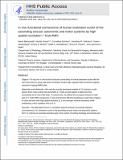In vivo functional connectome of human brainstem nuclei of the ascending arousal, autonomic, and motor systems by high spatial resolution 7-Tesla fMRI
Author(s)
Bianciardi, Marta; Toschi, Nicola; Eichner, Cornelius; Polimeni, Jonathan R; Setsompop, Kawin; Brown, Emery Neal; Hämäläinen, Matti S; Rosen, Bruce R; Wald, Lawrence L; ... Show more Show less
DownloadAccepted version (3.244Mb)
Open Access Policy
Open Access Policy
Creative Commons Attribution-Noncommercial-Share Alike
Terms of use
Metadata
Show full item recordAbstract
© 2016, ESMRMB. Objective: Our aim was to map the in vivo human functional connectivity of several brainstem nuclei with the rest of the brain by using seed-based correlation of ultra-high magnetic field functional magnetic resonance imaging (fMRI) data. Materials and methods: We used the recently developed template of 11 brainstem nuclei derived from multi-contrast structural MRI at 7 Tesla as seed regions to determine their connectivity to the rest of the brain. To achieve this, we used the increased contrast-to-noise ratio of 7-Tesla fMRI compared with 3 Tesla and time-efficient simultaneous multi-slice imaging to cover the brain with high spatial resolution (1.1-mm isotropic nominal resolution) while maintaining a short repetition time (2.5 s). Results: The delineated Pearson’s correlation-based functional connectivity diagrams (connectomes) of 11 brainstem nuclei of the ascending arousal, motor, and autonomic systems from 12 controls are presented and discussed in the context of existing histology and animal work. Conclusion: Considering that the investigated brainstem nuclei play a crucial role in several vital functions, the delineated preliminary connectomes might prove useful for future in vivo research and clinical studies of human brainstem function and pathology, including disorders of consciousness, sleep disorders, autonomic disorders, Parkinson’s disease, and other motor disorders.
Date issued
2016Department
Martinos Imaging Center (McGovern Institute for Brain Research at MIT)Journal
Magnetic Resonance Materials in Physics, Biology and Medicine
Publisher
Springer Science and Business Media LLC